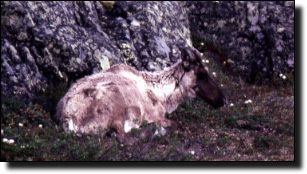
Subsistence
The faunal assemblage is overwhelmingly dominated by caribou. In one analyzed sample of 5170 specimens from hut 3 floor 1, 98.8% of identified bone is caribou, with comparable figures in the floors of other huts. In total, each hut yielded about 30,000 caribou bones and fragments, distributed mainly on either side of the door for each occupation level. The sheer volume of caribou bone precluded air shipment of more than a representative sample, so precise MNI (Minimum Number of Individuals) or NISP (Number of Identified Specimens) counts of caribou are unavailable.
A study of caribou bone epiphyseal fusion and tooth eruption based on 622 elements from hut 3 floor 1 show:
|
 Picture 1 A caribou. |
This suggests the selective hunting of 2-3 year old adults.
Non-caribou bone include 788 elements sent to Ottawa for further analysis. Of these, 563 elements (71.5%) were identified to order, including:
|
 Picture 2 A rock ptarmigan. |
||||||||||||||||||||||||||||||||||||||||||||||||||||
Note: The red squirrel specimen is entirely out of range, and its presence in the site is unexplained.
Bird bones, mostly shaft fragments, include red-throated loon, swan, Ross and white-fronted goose, northern pintail, green-winged teal, oldsquaw, red-breasted merganser, duck family, herring gull, jaeger, short-eared owl, lesser golden plover, and rock and willow ptarmigan. Only ptarmigan are permanent residents near Nadlok, the rock variety inhabiting elevations where caribou spotters congregated, and the willow variety in the low wet areas adjoining the site.

Picture 3 An arctic hare.
Only 2.3% of non-caribou bone are fish, and include lake trout, grayling, arctic char, round and lake whitefish and least cisco. We were able to catch the first three species in the deep pool at the lower caribou crossing using casting rods and spinners or plugs.

| Previous Page: Artifacts | | | Table of Contents | | | Glossary | | | Next Page: Comparisons |